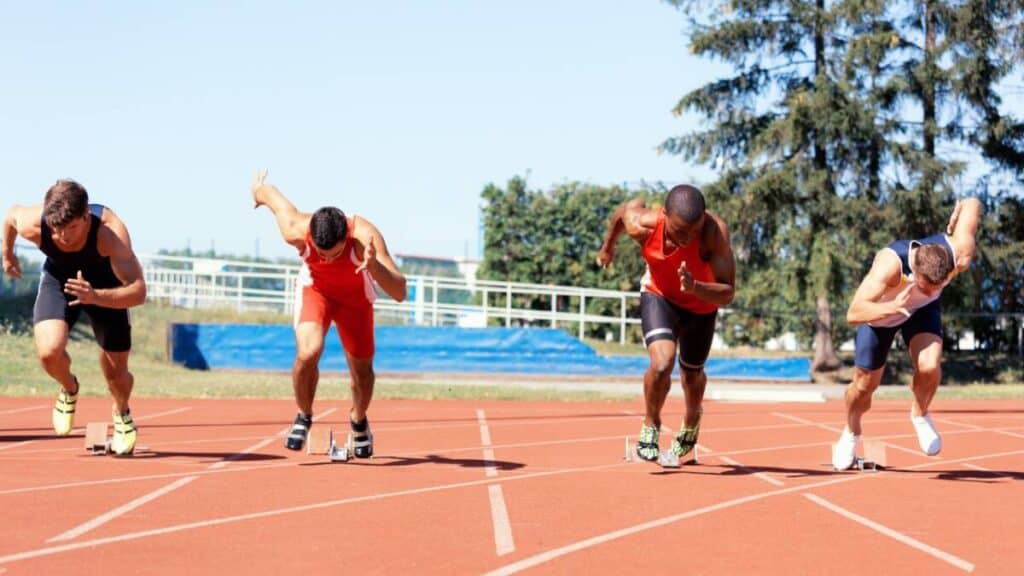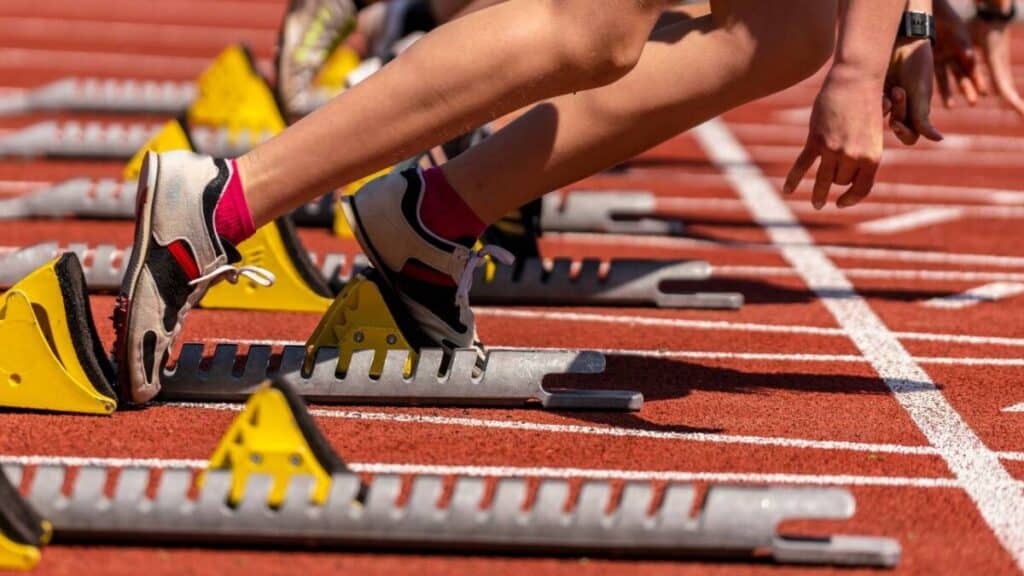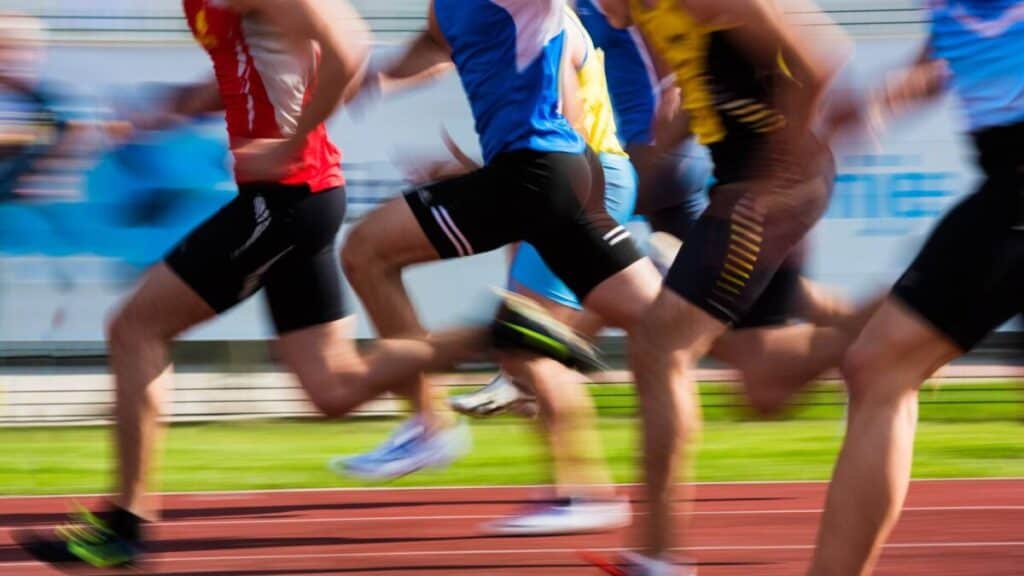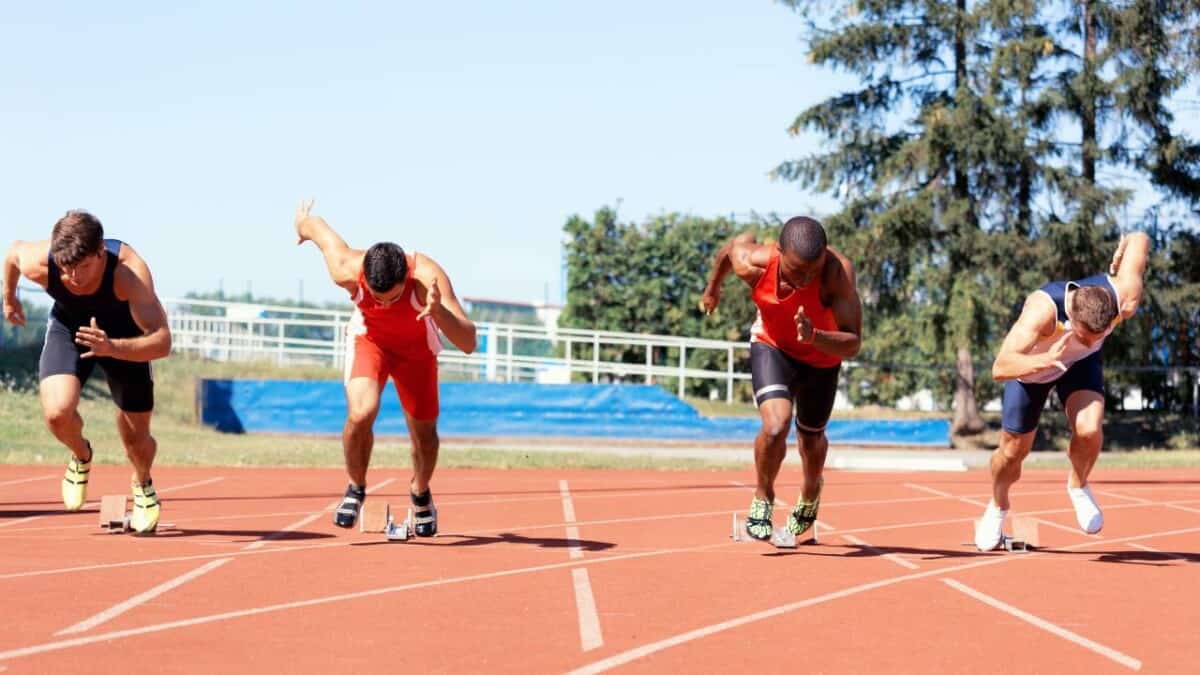Running is one of the most popular sports in the world, with millions of people participating in races of various distances every year. One of the most challenging and demanding races is the 400-meter race. This race is a true test of speed, endurance, and mental toughness, as runners must maintain a fast pace for an entire lap around the track.
Table of Contents
Average Time to Run 400m By Age

The average time to run 400m is between 54 seconds and 90 seconds for most people. Elite runners can run 400m in 43-48 seconds. Of course, depends on a variety of factors, including age, gender, fitness level, and experience.
However, there are some general guidelines that can help runners understand what a good time is for their age and skill level. A basic look at the average time to run 400m is given in this table below.
| Age Group | Male | Female |
|---|---|---|
| High School | 54 seconds | 58 seconds |
| Average Joe | 70-90 seconds | 70-90 seconds |
| Elite Runners | 45-47 seconds | 45-47 seconds |
However, your 400m time is best estimated against people in your age and gender group. Therefore, a more detailed table below gives the average 400m run time by age and gender. Obviously, this is the average time for non-elite runners.
| Age Group | Male | Female |
|---|---|---|
| 14-15 | 58.5 seconds | 1:08.0 minutes |
| 16-17 | 54.5 seconds | 1:04.0 minutes |
| 18-19 | 51.5 seconds | 1:00.0 minutes |
| 20-29 | 49.5 seconds | 57.5 seconds |
| 30-39 | 51.5 seconds | 59.0 seconds |
| 40-49 | 56.0 seconds | 1:05.0 minutes |
| 50-59 | 1:02.0 minutes | 1:12.0 minutes |
| 60-69 | 1:10.0 minutes | 1:22.0 minutes |
💡Struggling with stubborn weight that won’t budge? Tired of yo-yo diets and empty promises? Say goodbye to past failures and hello to guaranteed success with our fail-proof, personalised calorie plans! Uncover scientifically-backed strategies that make weight loss effortless, helping you shed up to 24 pounds in just 12 weeks. This isn’t a fad; it’s a lifestyle transformation. Don’t miss out—your journey to a slimmer, more confident you is just one click away!
Check out my complete data list of all track running distances and the most popular running distances by age, gender and ability, average running times the complete guide.

What is the 400m Run?
The 400m race is a track and field event that involves running one lap of a standard outdoor running track. It is a sprint race, but it also requires endurance since the athletes have to maintain their speed for the entire lap. The race is run in staggered positions, with each athlete starting in their designated lane.
The 400m race is a popular event in track and field competitions, including the Olympic Games and World Championships. It is also a common event in high school and college track meets.
According to World Athletics Championships, the race is determined on time, with the fastest athlete winning, the second-fastest finishing as the runner up, and so on. The athletes must stay in their designated lane throughout the race, and if they step out of their lane, they risk disqualification.
| Distance | Laps | Starting Position | Track Lane |
|---|---|---|---|
| 400m | 1 | Staggered | Designated Lane |

Factors Affecting the Average Time to Run 400m
The average time to run 400m can be affected by a number of factors, including:
- Age: As athletes get older, their average time to run 400m tends to increase. This is because the body’s ability to perform at high-intensity levels decreases with age.
- Gender: On average, males tend to run faster times than females due to differences in muscle mass and hormones.
- Training: Athletes who engage in regular training and conditioning programs tend to have faster times than those who don’t. This is because training helps to improve endurance, speed, and overall fitness levels.
- Technique: Proper running technique can also affect the average time to run 400m. Athletes who have good running form and mechanics tend to be more efficient and use less energy, resulting in faster times.
- Environmental Conditions: The temperature, humidity, and altitude of the environment can also affect the average time to run 400m. Hot and humid conditions can make it more difficult to perform at high-intensity levels, while high altitude can decrease oxygen levels, making it harder to breathe.
To further illustrate the impact of these factors, the table below shows average 400m times for different age groups and genders:
| Age Group | Male | Female |
|---|---|---|
| High School | 54 seconds | 58 seconds |
| Average Adult | 70-90 seconds | 70-90 seconds |
| Elite Runner | 45-47 seconds | 45-47 seconds |

Average time to run 400m: Data table analysis
Running the 400m is a challenging task that requires a combination of speed, endurance, and technique. Many factors can affect the average time to run 400m, such as age, gender, fitness level, and training regimen. To provide a better understanding of the average time to run 400m, a data table analysis was conducted using various sources.
| Age Group | Gender | Average Time (seconds) |
|---|---|---|
| High School | Male | 54 |
| High School | Female | 58 |
| Average Joe | Both | 70-90 |
| Elite Runners | Both | 45-47 |
According to the data table, the average time for a high school male runner in a 400m race is 54 seconds, while for females of that age group, it is 58 seconds. For the average Joe off the streets, the average time for the 400m is between 70 and 90 seconds. However, elite runners can complete the race between 45 and 47 seconds, which is an impressive feat.
It is essential to note that the data table only provides a general idea of the average time to run 400m. Many factors can affect individual performance, such as genetics, training, and nutrition. Therefore, it is crucial to consult a professional coach or trainer to develop a personalized training program that suits individual needs and goals.
In conclusion, the data table analysis provides valuable insights into the average time to run 400m. While the average time varies depending on several factors, the data table can help individuals set realistic goals and track their progress over time.

How to Improve Your 400m Race Time
Improving your 400m race time requires a combination of physical and mental training. Here are a few tips to help you improve your performance:
- Interval Training: Running intervals of 50 meters at 90 percent effort on a track can improve your start and the initial phase of the race. Take full recovery between each interval by walking slowly back to the starting line and then waiting a full 60 seconds until your next bout.
- Tempo Runs: Tempo runs can help you build endurance and improve your stamina. Your tempo should be based on your anticipated 400-meter time. Use a stopwatch to time each interval. For example, if you want to run a 50-second 400-meter sprint, perform 200-meter interval workouts in 23 to 25 seconds.
- Strength Training: Strength training can help you build muscle and improve your overall fitness. Incorporate exercises such as squats, lunges, and deadlifts into your workout routine to help you build strength and power.
- Mental Training: Running a successful 400m race requires mental toughness and focus. Practice visualization techniques to help you visualize yourself running a successful race. Stay focused on your goals and push yourself to achieve them.
By incorporating these training techniques into your workout routine, you can improve your 400m race time and achieve your goals. Remember to stay focused, stay motivated, and keep pushing yourself to be the best that you can be.

Other Track Running Times You Might Find Helpful;
Average Time to Run 400m Summary
Based on the data presented in this article, it is clear that the average time to run 400m varies greatly depending on age, gender, and level of athleticism. For high school runners, the average time for males is 54 seconds and for females is 58 seconds. For the average person, a time of 70 to 90 seconds would be considered average, while elite runners can complete the race in as little as 45 to 47 seconds.
It is important to note that these times are not set in stone and can vary depending on a variety of factors, such as training, nutrition, and overall health. Additionally, it is important to set realistic goals and work towards them gradually, rather than trying to achieve an unrealistic time right away.
Whether you are a seasoned athlete or just starting out, the 400m race can be a challenging but rewarding experience. By setting achievable goals and working hard to improve your time, you can become a better runner and achieve your full potential.
| Age Group | Male Average Time | Female Average Time |
|---|---|---|
| High School | 54 seconds | 58 seconds |
| Average Person | 70-90 seconds | 70-90 seconds |
| Elite Runner | 45-47 seconds | 45-47 seconds |



